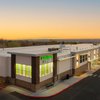Research shows that buyers are prioritising connectivity and community more than ever before, and it’s changing how neighbourhoods are being developed.
Research that informed REA Group’s recent developer insights series found homebuyers expect more developments to embrace the hyperlocal concept, which encourages living locally by providing all daily necessities within a short distance.
The latest edition of the annual new homes research, which polls new homebuyers about their buying behaviour and preferences, found 38% of those surveyed see walkable neighbourhoods as the future of housing.
Of these homebuyers, 60% said developers should create developments that promote social communities.
Now, research from Mirvac has highlighted walkability as one of the top trends new homebuyers want in 2025.
According to REA Group's recent research, 38% of respondents view walkable neighborhoods as the future of housing. Picture: Getty
The bi-annual report from the property developer investigates key insights on buyer preferences and intentions when buying new homes, including apartments, houses in masterplanned communities, and townhomes.
According to the developer’s latest Property Choices research, which surveyed over 2000 Mirvac leads and purchasers across NSW, Queensland, Victoria and Western Australia, the importance of walkability and hyperlocal continues to increase.
When surveyed on the top location features, transport was ranked as number one across both masterplanned and apartment developments among homebuyers.
“We are seeing customers place increasing importance on their immediate local area and community – they want key features and facilities that are important to them to be walking distance away - as the research highlights, with parks and gardens, convenience shopping, casual dining and healthcare among the top responses when it comes to location,” Mirvac CEO of development Stuart Penklis said.
“It’s no surprise that public transport was number one across masterplanned and apartment communities – reinforcing the desire to rely less on a car.”
Parks and gardens, everyday convenience shopping and healthcare also ranked highly as most wanted location features across both apartments and masterplanned communities.
Mirvac's recent Property Choices research reveals transport as the top priority for homebuyers. Picture: Getty
Whereas sporting facilities, boutique and leisure shopping, and destination dining opportunities weren’t ranked highly for location features in masterplanned communities.
Similarly in apartments, destination dining and shopping weren’t favourable as well as playgrounds.
Among community amenities, swimming pools, BBQ areas, community gardens and shared gym spaces had universal appeal across both segments.
Private training spaces, a games and music room ranked low as priorities for community amenities across both categories. But a shared workspace was the least favourable for apartment buildings.
This importance of connectivity continues to rise across Australia, with many developers shaping their communities around this concept.
For Sydney developer ALAND, it’s a key factor for buyers, with many prioritising locations close to transport, schools, universities and essential services.
Head of sales Scott Rudgley said it is also a determining factor for the developer when tailoring a project towards a community.
"Connectivity is a key consideration, we position our developments near shopping precincts, transport links, educational institutions, and employment hubs to enhance convenience and liveability,” Mr Rudgley said.
“Our Jasmine development, for example, offers access to Liverpool, Parramatta CBD, Sydney CBD and Norwest via the new Metro and nearby Schofields train station.”
What do buyers want inside their homes?
Across apartments and masterplanned communities, respondents to Mirvac’s survey showed a high interest in sustainable features, with 50% indicating a preference for an all-electric home.
Almost a third of respondents said they would pay extra for the installation of solar panels. Only seven per cent said they would not pay extra for any sustainability features, which saw a drop compared to 17% in 2022.
“We are seeing real momentum globally, as well as locally, towards all-electric homes and buildings and a major shift in customer sentiment, which we are responding to by ensuring all-electric is ubiquitous across all our developments,” Mr Penklis said.
Smart in-house security ranked highly across both typologies for in-home features.
“But classic home features and inclusions such as high ceilings and quality kitchen appliances continue to rate highly as must-haves across apartments and masterplanned communities,” Mr Penklis said.
Are you interested in new developments? Check out our New Homes section.



















 English (US) ·
English (US) ·